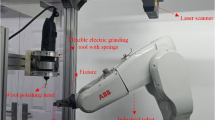Abstract
In the robotic polishing system for the wheel hubs, initial point alignment is a very important procedure before the robot starts to polish. Since the surface shapes of the wheel hubs are complex, traditional contact sensors are not suitable for the initial point alignment. Therefore, this paper presents a vision-based initial point alignment control method due to the merits of non-contact and high precision of the vision sensor. The main procedures of the new proposed initial point alignment methods are as follows. Firstly, the center point of the wheel hub is computed based on the growth of sampled points (GSP) method. Secondly, the center lines of the spokes of the wheel hub are extracted based on the edges of the spokes. Based on the center point and the center lines of the spokes, the needed rotation angle of the wheel hub denoting the current and target initial points can be computed. Thirdly, an alignment controller is designed to align the current initial point with the target one. Finally, experiments are well conducted to demonstrate the effectiveness of the proposed initial point alignment control method for the wheel hubs.











Similar content being viewed by others
References
Luo SJ, Fu YT, Zhou YX (2012) Perceptual matching of shape design style between wheel hub and car type. Int J Ind Ergon 42(1):90–102
Ehsan F, Mahdi M, Paul DK, Homer R, Gareth T, Alan W, Robert W (2017) Effect of mesh phasing on the transmission efficiency and dynamic performance of wheel hub planetary gear sets. Proceedings of the Institution of Mechanical Engineers, Part C: Journal of Mechanical Engineering Science 232(19):3469– 3481
Osma A (2009) A statistical approach to comparing wheel hub forging processes. Proceedings of the Institution of Mechanical Engineers, Part D: Journal of Automobile Engineering 223(12):1559–1576
Tian FJ, Li ZG, Lv C, Liu GB (2016) Polishing pressure investigations of robot automatic polishing on curved surfaces. Int J Adv Manuf Technol 87(1-4):639–646
Wang GL, Wang YQ, Zhang L, Zhao J, Zhou HB (2014) Development and polishing process of a mobile robot finishing large mold surface. Mach Sci Technol 18(4):603–625
Ahmed K, Du TT, Zhang YJ (2017) A practical approach for automated polishing system of free-form surface path generation based on industrial arm robot. Int J Adv Manuf Technol 93:3921–3934
Mohammad A, Hong J, Wang D (2018) Design of a force-controlled end-effector with low-inertial effect for robotic polishing using macro-mini robot approach. Robot Comput Integr Manuf 49:54–65
Ren CX, Gong YQ, Jia F, Wang XS (2016) Theoretical analysis of a six-axis force/torque sensor with overload protection for polishing robot. In: Proceeding of the 23rd international conference on mechatronics and machine vision in practice, 28-30 Nov. 2016, Nanjing, China
Lin FY (2014) Path generation for robot polishing system based on cutter location data. Advanced Materials Research 902:250–253
Liu J, Huang XL, Fang SW, Chen HP, Xi N (2016) Industrial robot path planning for polishing applications. In: Proceedings of the IEEE international conference on robotics and biomimetics, 3-7 Dec. 2016, Qingdao, China
Zhang XD, Chen H, Yang N, Lin H, He K (2017) A structure and control design of constant force polishing end actuator based on polishing robot. In: Proceedings of the IEEE international conference on information and automation, 18-20 July 2017, Macau, China
Mohammad A, Hong J, Wang DW, Guan YS (2019) Synergistic integrated design of an electrochemical mechanical polishing end-effector for robotic polishing applications. Robot Comput Integr Manuf 55:65–75
Mohsin I, He K, Cai J, Chen H, Du R (2017) Robotic polishing with force controlled end effector and multi-step path planning. In: Proceedings of the IEEE international conference on information and automation, 18-20 July 2017, Macau, China
Xie XH, Sun LN (2016) Force control based robotic grinding system and application. In: Proceedings of the 12th world congress on intelligent control and automation, 12-15 June 2016, Guilin, China
Feng DY, Sun YW, Du HP (2014) Investigations on the automatic precision polishing of curved surfaces using a five-axis machining centre. Int J Adv Manufact Technol 72:1625C1637
Agustina BD, Marin MM, Teti R, Rubio EM (2014) Surface roughness evaluation based on acoustic emission signals in robot assisted polishing. Sensors 14(11):21514–21522
Segreto T, Karam S, Teti R (2017) Signal processing and pattern recognition for surface roughness assessment in multiple sensor monitoring of robot-assisted polishing. Int J Adv Manufact Technol 90:1023–1033
Fang ZJ, Xu D, Tan M (2013) Vision-based initial weld point positioning using the geometric relationship between two seams. Int J Adv Manufact Technol 66:1535–1543
Zhu ZY, Lin T, Chen SB (2005) Recognition of the initial position of weld based on the image pattern match technology for welding robot. Int J Adv Manufact Technol 26:784–788
Rafael CG, Richard EW (2017) Digital image processing. Publishing House of Electronics Industry, Beijing
Otsu N (1979) A threshold selection method from gray-level histograms. IEEE Trans Sys Man Cybern 9(1):62–66
Funding
This work was supported by the National Key R&D Program of China (Grant No. 2018YFB1308900), the National-Zhejiang Joint Natural Science Foundation of China (Grant No. U1909215), the Key R&D Program of Zhejiang Province (Grant No.2018C01086), and Equipment Advanced Research Fund of China (Grant No.6140923010102).
Author information
Authors and Affiliations
Corresponding author
Additional information
Publisher’s note
Springer Nature remains neutral with regard to jurisdictional claims in published maps and institutional affiliations.
Rights and permissions
About this article
Cite this article
Fang, Z., Li, J., Zhang, C. et al. Vision-based initial point alignment control for the wheel hubs in the robotic polishing system. Int J Adv Manuf Technol 111, 1471–1481 (2020). https://doi.org/10.1007/s00170-020-06125-9
Received:
Accepted:
Published:
Issue Date:
DOI: https://doi.org/10.1007/s00170-020-06125-9



